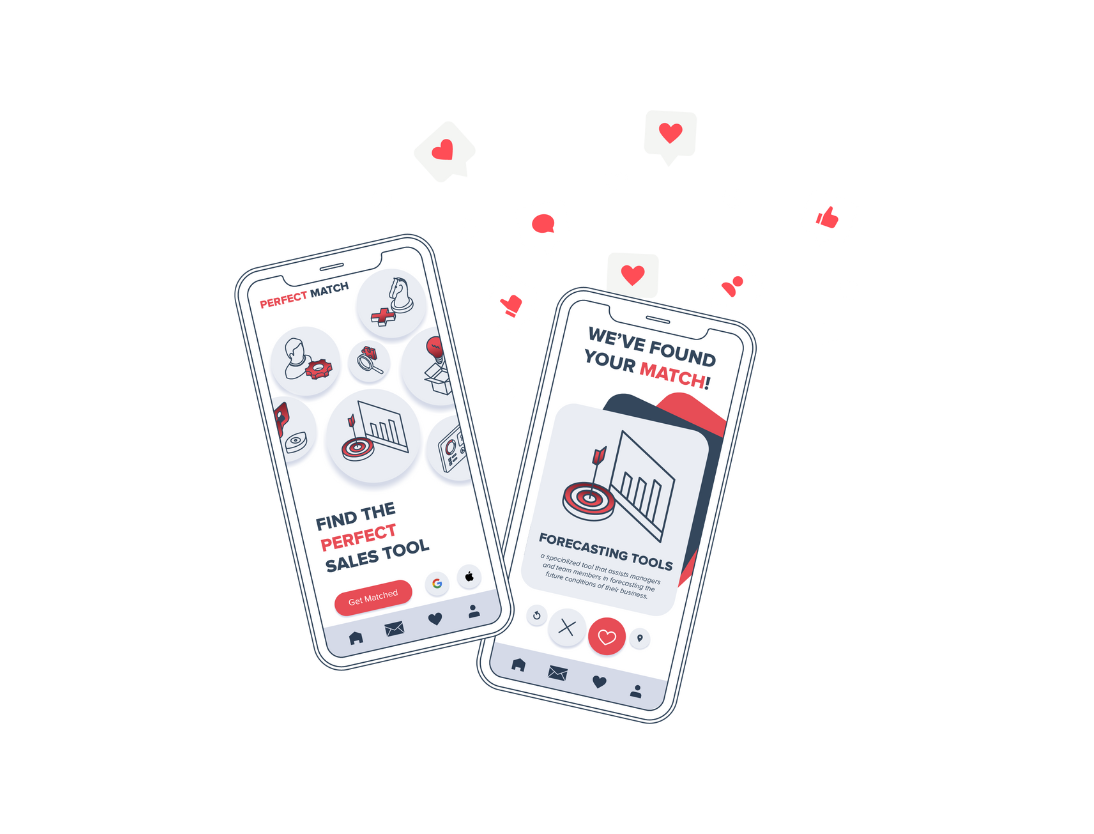61% of salespeople agree that it's more difficult to get in front of prospects than it was seven years ago — according to Sales Insights Lab research. Within a challenging sales environment, companies are growing their pipeline by combining outbound and inbound sales strategies, an approach enabled by the HubSpot platform.
Lennon and McCartney. Luke and Han. Mr Darcy and Elizabeth Bennet. Not only do opposites attract, but they also complement each other.
So you don't have to pick a side when it comes to inbound vs. outbound sales strategies. Combining these strategies creates a best-of-both-worlds approach that drives sales with better leads.
Before exploring how to, let’s unpack what makes these strategies so distinct.
Outbound vs. inbound: the key differences explained
Inbound operates on a simple premise: that people no longer want to be interrupted by salespeople or marketers. As a result, prospects take the initiative to discover products. Effectively, the power in the buying process has shifted from the seller to the buyer.
Instead of interrupting prospects with sales pitches, the inbound approach aims to attract leads through valuable marketing materials.
By the time the inbound salesperson is presented with a lead, the contact will have already engaged with your brand and content.
This is why inbound leads are considered a better fit than outbound leads — they already know who you are and what you're about.
Unlike the inbound approach, where customers come to you, outbound sales involve searching for and reaching out to leads.
Traditionally associated with cold calls, cold emails, and outdoor advertising, outbound is often seen as the outdated fuddy-duddy of the sales and marketing world.
But it's still an effective sales strategy.
A study by Rain Group reveals that 82% of buyers still accept meetings with salespeople who reach out to them, as long as the sales messaging is relevant to their needs.
As the buyer's journey is different for everyone, there are situations where an outbound approach is needed to convert leads into customers. Some leads, for instance, just don't want to engage with content, no matter how expertly crafted.
Others simply ‘don't know what they don't know,' and are unaware that they have challenges that can be overcome with the right product or service. Outbound prospecting strategies enable you to engage with prospects who can't be reached through inbound selling.
Let's say you sell custom-built homes in family-oriented communities, a novel concept for your area. To drive sales, you look to partner with a successful local realtor group. Even if the realtor hasn't engaged with your brand or content, it doesn't mean they aren't interested.
Your top salesperson cold calls the principal of the realtor group and explains how your homes are perfectly suited to grow families. With a personalised sales pitch, you've made the realtor aware of your brand and product.
But they aren't ready to partner with you yet. To warm up your new prospect, you share sales enablement resources such as blog posts, ebooks, videos, and product guides. These materials were developed to fuel your inbound strategy and are a way for prospects to engage with your brand.
Outbound marketing often involves pushing a message out to a broad audience, such as through advertisements, cold calls, and direct mail. On the other hand, inbound marketing focuses on creating valuable content to draw potential customers in, such as through blogs, social media, and search engine optimisation.
The benefits of inbound sales
Inbound sales offer several advantages, including the ability to attract qualified prospects, prioritise marketing efforts, and establish customer loyalty.
By focusing on creating valuable, relevant content, inbound sales naturally attracts prospects who are already interested in the products or services being offered, resulting in a higher likelihood of closing sales.
Additionally, the focus on pre-qualified leads and addressing customer needs makes inbound sales more cost-efficient than outbound sales, as it minimises time and resources spent on pursuing uninterested or unqualified prospects.
The data-driven nature of the inbound methodology also contributes to its effectiveness. By analysing metrics such as website traffic, email open rates, and customer behaviour, businesses can make more informed decisions about their marketing and sales strategies.
This empowers companies to continuously improve their approach and adapt to the changing needs and preferences of their target audience.
The focus on attracting qualified prospects, addressing customer needs, and using data-driven insights all work together to make inbound sales a powerful and cost-efficient approach to growing a customer base and increasing revenue.
The benefits of outbound sales
Outbound sales offer a proactive approach to reaching potential customers, allowing sales representatives to take the lead in shaping conversations and orchestrating meaningful connections.
This dynamic sales approach presents multifaceted benefits, including the ability to target specific prospects, personalise interactions, and drive immediate results.
By actively seeking out and engaging with potential clients, outbound sales teams can create a sense of urgency and build rapport, ultimately leading to higher conversion rates and increased revenue.
One of the key advantages of outbound sales is the ability to control and optimise the sales process, from the initial outreach to closing the deal.
This proactive approach allows sales representatives to guide the conversation and address any objections or concerns in real-time, resulting in more effective communication and higher levels of customer engagement.
Additionally, outbound sales enable companies to reach a wider audience and expand their market presence, ultimately driving growth and success.
To succeed in outbound sales, it is essential to have a well-defined target audience, a thorough understanding of the product or service being offered, and a strategic approach to prospecting and outreach.
By leveraging sales enablement tools, data, and personalised messaging, sales teams can maximise the impact of outbound sales efforts and achieve tangible results.
Can inbound sales and outbound sales work independently?
In a business setting, inbound and outbound sales strategies are interdependent and complement each other to achieve sales success.
While they may seem distinct, these strategies are interconnected. For example, inbound efforts can create a pipeline of warm leads for outbound teams to nurture and close, while outbound efforts can create brand awareness and drive traffic for inbound teams to convert.
Both teams can work together by sharing insights and data, coordinating on lead handoffs, and aligning messaging for a cohesive customer experience.
To integrate both strategies effectively, businesses must consider key factors such as lead qualification, communication between teams, technology and tools, and tracking and analysing performance metrics.
The synergy between inbound and outbound sales is essential for driving revenue and maximising sales potential in a competitive market.
Therefore, while they can operate independently, the two strategies thrive best when they work hand in hand.
Inbound vs. outbound sales: when should you use each?
When deciding between inbound and outbound sales, it is important to consider several key factors. Firstly, analyse your business model and determine how your products or services are best sold.
Consider the industry you operate in as well, as different industries may respond better to either inbound or outbound sales tactics. Understanding your buyers and their preferences is also crucial, as this will heavily influence which strategy is most effective.
Inbound sales may be more suitable if your business model is based on creating value through informative content and building relationships with customers.
On the other hand, outbound sales could be more effective if your industry requires a more aggressive approach to generate leads and close sales.
The decision to use inbound or outbound sales should be based on a careful analysis of your business model, the industry you operate in, and the preferences of your buyers.
By considering these factors, you can determine which strategy is best suited to your company's unique needs.
Using HubSpot to connect your inbound and outbound selling
HubSpot is famous for helping pioneer inbound selling. But what many people don't know is that the platform is also built to supercharge outbound activities, making it easy to handle both inbound and outbound sales from the same system. Popular outbound features include:
- Sales prospecting tools — generate a detailed database of leads. Then make contact using email templates and call scripts that are easily personalised to fit each lead. By creating your sales playbook in HubSpot, your teams will be aligned on sales messaging and processes.
- Communication and engagement tracking — track the results of prospecting activities and know when leads click links and open emails or attachments. Schedule future emails or meeting invites that are triggered by their response or lack of response.
- Sales automation — automatically log all rep activity, create follow-up tasks, enable leads to book time with you, and use the workflow feature to automate time-consuming tasks.
- Monitor sales performance — from first contact to closed deal, track all sales activities from the same dashboard. With a clear sightline over sales metrics, you can see what works and what doesn't.
Once outbound leads enter your inbound ecosystem, HubSpot's famed toolset helps you warm up cold leads until they're ready to convert.
By executing both strategies out of HubSpot, you'll have a 360-degree view of all your leads and sales efforts.
Inbound and outbound: How to officiate the marriage
Inbound helps prospects find your business, learn about your brand and solutions, and convert on their terms. On the other end of the spectrum, outbound is a crucial strategy for securing customers who wouldn't have found you any other way.
Platforms like HubSpot make it easy to grow your pipeline by combining both strategies. But setting up and maximising your HubSpot use comes with its own set of unique challenges. At Huble, our expert-led sales consultancy has helped many businesses to set up HubSpot and improve their inbound results with outbound sales strategies.
Speak with our team to learn about how you can integrate your inbound and outbound sales processes.













